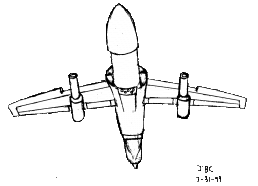

Mass: 50 tons
Frame: ConfedAir Shrike
Power Plant: Rolls-Kraken Turbojet 100
Cruise Speed: 360 kph
Maximum Speed: 540 kph
Manufacturer: ConfedAir
Primary Factory: Alphard
Communications System:
Targeting and Tracking System:
The Shrike was designed as a low-cost ground support craft. With its massive firepower providing the ability to annihilate 'mechs in a single pass, it has been very successful in that role. Despite its low speed and almost complete lack of armor, it is also surprisingly effective against light and medium aerospace fighters.
The usual design conventions for atmospheric fighters involve light armament and a large engine to provide the speed and maneuverability to offset the light armor practically required by aerodynamic considerations. The Shrike reverses that formula. If its engine were any smaller, it would be unable to get off the ground, while its firepower is unmatched. The twin Mydron autocannons slung under its wings total more than half of the weight of the craft.
The Shrike was designed as a ground attack craft, and it is brutally good at its job. Its low speed is more than sufficient for engaging and evading ground targets, and its firepower gives it one-shot-kill capability against even heavily armored assault 'mechs. There have been recorded instances of lone Shrikes ambushing and destroying entire battlemech lances. While a single shot striking its relatively fragile airframe could destroy a Shrike, quite often opposing 'mechs never get the chance to fire that shot before being ripped in half by high-velocity autocannon slugs.
Shrikes generally don't fare as well in dogfighting against heavier aerospace fighters. Fighters have the speed the Shrike lacks, and usually have the advantage in range and armor as well. The combination of those three factors usually spells serious trouble for the Shrike. Against light fighters, however, with the notable exception of the Seydlitz, the aerospace fighter lacks the range advantage, and when it closes to use its short-range guns, the Shrike uses its own short-range guns, and the fight is over. Very few light fighters have the armor to handle even a single hit from one of the Shrike's autocannons. The Holly LRM rack makes standing off and waiting for the big fighters to arrive a tricky proposition, too. That is, in fact, the entire reason the missiles were added. The original Shrike design carried three more tons of autocannon ammunition instead of the Holly rack, but the designers determined that, with the Shrike's armor being so light, its expected life expectancy was low enough that it would probably not use even the three tons they left it with.
There are no Shrike variants currently in service. However, an upgraded version is being tested at Confederate military research centers. The Shrike II-X drops the Holly rack and replaces the autocannons with still-experimental Ultra models. The loss of the token long-range fire capability is considered to be an acceptable price to pay to gain the ability to deliver twice as much firepower on target in the same amount of time as the current Shrike. Given the current Shrike's already impressive capabilities in that area, the Shrike II-X promises to be truly fearsome.
It is likely that all existing Shrikes will be refitted with the improved autocannons when they come out of testing. That day may be far in the future, however. The Ultra autocannon still has serious problems with jamming. One of the prototype II-Xes was lost during combat testing, in fact, when one of its autocannons jammed and exploded, blowing the wing off.